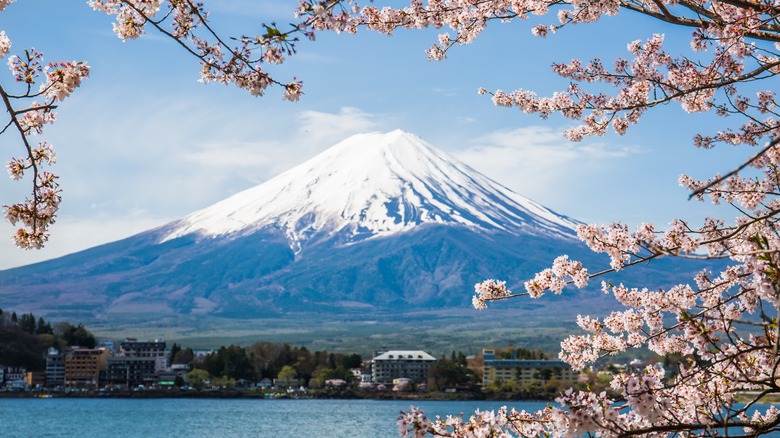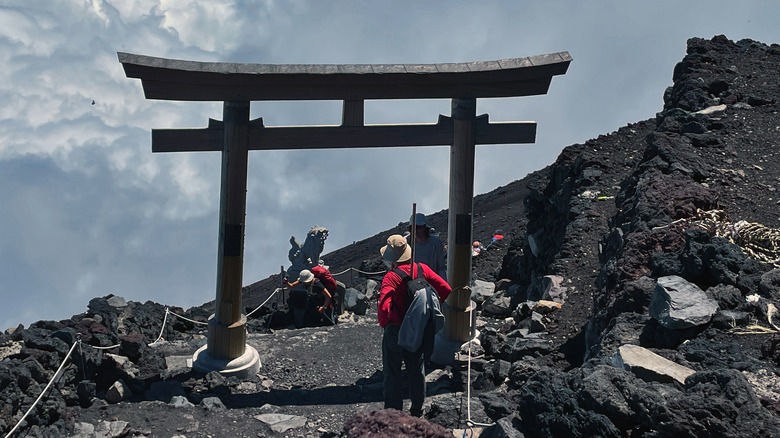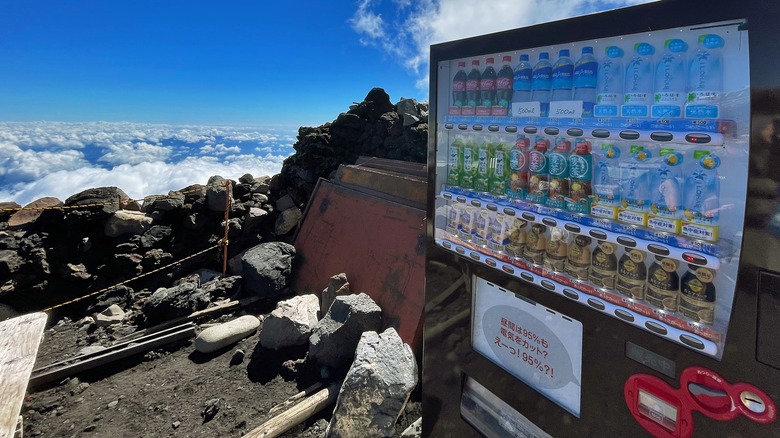The Scary Reason Climbing Japan's Iconic Mount Fuji Is Prohibited For Most Of The Year
Snow-capped Mount Fuji, almost perfect in its elegant symmetry, is the most iconic image in Japanese art. An active volcano that last erupted in the 1707, Fuji is held sacred by many Japanese people, for whom a pilgrimage to the summit of "Fujisan" is a summer tradition of long standing. A UNESCO World Heritage Site, Mount Fuji is summited by 200,000 people a year during the short climbing season (per Japan National Tourism Organization), which runs from July 1 through September 10 on the most popular Yoshida route. But there's a good reason for that short season, and that's the absolute brutality of the freezing wind that whips around Mount Fuji's high, cratered peak, rendering it unapproachable by ordinary hikers for all but a couple months out of the year.
At 12,389 feet, Fuji is the tallest mountain in Japan, but it's still modest as mountains go — Colorado's awe-inspiring and dangerous Lone Peak is just one of 58 mountains in that state over 14,000-feet tall, for instance. Fuji even has a well-developed set of trails to the top, with no special skills required to reach the summit when the snow has melted. Still, the average annual temperature atop Mount Fuji is just 19 degrees Fahrenheit, and it almost never rises above freezing, even at the height of summer. Even within the short summer window, the weather can turn deadly at a moment's notice.
What is the weather like on Mount Fuji?
The weather on any mountain top can be changeable, but conditions on the summit of Mount Fuji are notoriously fickle, and that remains true during the summer climbing season. One Redditor wrote of nearing the summit only to encounter "ruthless" wind they described as "the kind where you'd probably fly off the mountain if you didn't hold on to your hiking sticks."
While many unprepared hikers have gotten lucky, hiking up and down within a favorable weather window, others have suffered for underestimating the length of the climbing day or being caught off-guard by a sudden and dangerous change in the weather. High winds and sideways rain can quickly cause the temperature near the summit to plunge, exposing unprepared climbers to increased risk of both hypothermia and altitude sickness. What's more, on a sweltering, 100-degree day, you could be at risk for heat stroke hiking at the lower elevations on Mount Fuji and hypothermia upon reaching the top.
Even if you've taken all the necessary precautions to avoid altitude sickness, you could still be at risk, and the only remedy for the early stages, characterized by nausea, headache and fatigue, is to descend. But that might prove difficult should you find yourself temporarily blinded by fog. Staying warm and taking your time is really the only way to safely summit Fujisan.
How to prepare for a safe hike up Mount Fuji
New rules for climbing Mount Fuji via the most popular Yoshida Trail took effect in 2024, along with a daily quota of 4,000 climbers. Entry is closed between 8 p.m. and 4 a.m. to discourage "bullet climbing," the practice of hiking all night to reach the summit in time for sunrise. The recommended practice is to reserve a dormitory bunk at a mountain hut at one of several stations along the route. Spending the night on the mountain lets your body acclimate. Your best defense on a summer summit bid is to dress for the weather, with a moisture-wicking base layer, an insulating layer (fleece is good; down is better), a wind shell, gloves, and a buff or scarf to protect your face from wind and driving, sideways rain.
You won't find contemplative solitude on this mountain, where the wide switchbacks can be thronged with visitors. For the kind of hike that involves peaceful forests and waterfalls, head for Nikko National Park, a favorite Japanese destination that won't break the bank. Fuji is an experience you share with your fellow man, as the various stations that line the route are equipped with huts for overnight stays, coin-operated toilets, hot meals, and canned oxygen for sale. A post office at the summit even lets you send a postcard to your mom telling her not to worry, and a vending machine (pictured) lets you buy a Coke.


